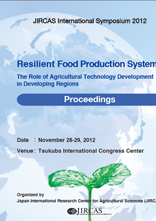Index-Based Livestock Insurance: Protecting Pastoralists from Drought-related Livestock Losses

This paper describes the design, logic and implementation of an award-winning innovation in the provision of
formal insurance to help drought-vulnerable livestock keepers manage the risk of widespread livestock mortality.
Much of the Horn of Africa is Arid and Semi-Arid lands (ASALs) populated by pastoralists. These are among the
most vulnerable populations in the region as their livestock-dominated livelihoods are constantly threatened by
increasingly severe droughts that has made the boom-and-bust dynamic a constant feature of their production
systems.
To help these populations better manage the risk of drought-related livestock losses, a pilot index-based
livestock insurance (IBLI) product was launched in January 2010 in Marsabit District of Northern Kenya. Indexbased
insurance products represent a promising and exciting innovation for managing the climate related risks
that vulnerable households face (www.ilri.org/ibli). This IBLI product has many innovative features. It appears
to be the first to develop the index insurance product from longitudinal household data so as to minimize basis
risk in product design. It is one of the first developed to protect the productive asset holdings of the poor and
vulnerable rather than just their income streams. It is one of the first to be based on more spatially distributed
remotely-sensed vegetation data, rather than rainfall series from a sparse set of fixed point meteorological stations,
as the IBLI index is derived from satellite-based normalized differenced vegetation index (NDVI) series that
summarize the state of rangeland forage availability at high spatiotemporal resolution. Finally, IBLI Marsabit
was designed to complement a new (unconditional) cash transfer program (the Hunger Safety Nets Program,
HSNP) the government launched in the area and the IBLI impact evaluation design explicitly enables identification
of the independent and synergistic effects of HSNP and IBLI as alternative means of addressing the risk and
financing constraints faced by the poor.
This paper will discuss the process of identifying, developing and implementing the IBLI project. We shall
highlight the design methodology of the insurance index, describe its key features and how it relates to the risk
profile and production system it seeks to manage. The paper will also touch on the determinants of uptake and
initial impact assessment results that are being generated. The paper will make use of the comprehensive project
panel data based on annual household surveys launched in October 2009. Aimed at allowing for rigorous analysis
of demand and impact assessment, the data employs an encouragement sampling design made up of differential
access to insurance educational extension (in the form of an experimental insurance game, which allows players
to learn the mechanics and value of IBLI) and discount coupons that, in varying the effective price of insurance,
allows the estimation of a demand curve and the relevant price elasticities.
The paper will tease out the implications of the analysis and the insights gained from implementation and draw
out recommendations to guide efforts at scaling up the IBLI project as well as improving client targeting and the
design of the product. Understanding the impact of various determinants will help identify effective approaches
to catalyzing demand; including the appropriate pricing strategy. This quantitative assessment will be supplemented
by the results of various qualitative interactions with clients, their representatives and various stakeholders in the
area to help develop context and draw insights to explain some of the analytical findings.
| Date of issued | |
|---|---|
| Creator | Andrew Mude |
| Subject |
Drought risk management index insurance pastoralists livestock mortality vegetation index |
| Publisher | Japan International Research Center for Agricultural Sciences |
| Available Online | |
| Issue | 2012 |
| spage | 68 |
| epage | 76 |
| Rights | Japan International Research Center for Agricultural Sciences |
| Language | eng |
